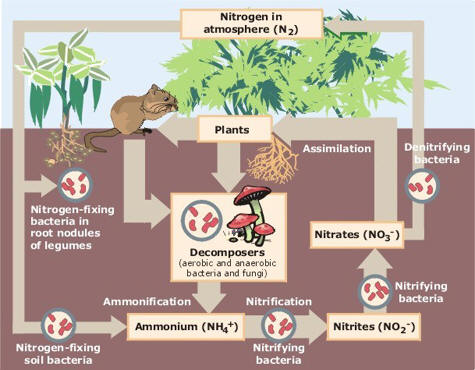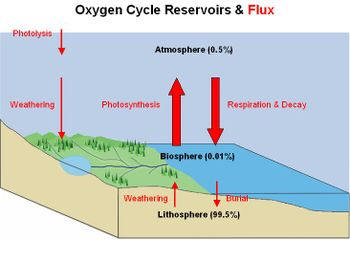Biogeochemical cyclesWe have adopted a model of the Earth System as a set of interacting “spheres”, the atmosphere, hydrosphere, biosphere, and lithosphere. Being open systems, energy and mass are constantly cycled between them. The transport and transformation of substances through the Earth system are known collectively as biogeochemical cycles. These include the hydrologic (water), nitrogen, carbon, and oxygen cycles. Nitrogen cycleNitrogen comprises 78.08 % of the atmosphere making it the largest constituent of the gaseous envelope that surrounds the Earth. Nitrogen is important in the make up of organic molecules like proteins. Unfortunately, nitrogen is inaccessible to most living organisms. Nitrogen must be “fixed” by soil bacteria living in association with the roots of particular plant like legumes, clover, alfalfa, soybeans, peas, peanuts, and beans. Living on nodules around the roots of legumes, the bacteria chemically combine nitrogen in the air to form nitrates (NO3) and ammonia (NH3) making it available to plants. Organisms that feed on the plants ingest the nitrogen and release it in organic wastes. Denitrifying bacteria frees the nitrogen from the wastes returning it to the atmosphere.
Figure 2.31 The Nitrogen Cycle Oxygen CycleOxygen is the second most abundant gas in Earth’s atmosphere and an essential element of most organic molecules. Though oxygen is passed between the the lithosphere, biosphere and atmosphere in a variety of ways, photosynthesizing vegetation is largely responsible for oxygen found in the atmosphere. The cycling of oxygen through the Earth system is also accomplished by weathering of carbonate rock. Some atmospheric oxygen is bound to water molecules from plant transpiration and evaporation. Oxygen is also bound to carbon dioxide and released into the atmosphere during animal respiration.
Figure 2.32 The Oxygen Cycle |


